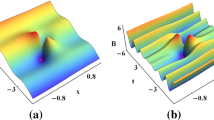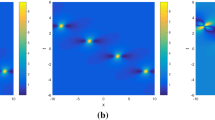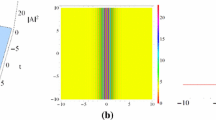Abstract
Under investigation in this paper is the generalized AB system, which is extended from the well-known AB system that is used to describe the evolution of the wave packets in a marginally stable or unstable baroclinic shear flow. Introducing an auxiliary function \(\alpha (\tau )\), we construct the Nth-order vector solitary waves for the generalized AB system, which are different from the regular vector solitary waves in the existing literature. We find that the vector solitary waves are subject to spatiotemporal distortion (SD) effects in the evolution. Influenced by the SD effects, the vector solitary waves would evolve with the shape changes or the appearances, splits, combinations and disappearances of certain bulges. It is revealed that the SD effects do not change the interaction properties of the vector solitary waves. Excluding from the SD effects, we find that the interacting vector solitary waves not only exhibit the same local and global oscillations as the scalar solitary waves of AB system, but also lead to certain unique inelastic interactions as they possess different velocities. It is also found that two vector solitary waves with the same velocity may degenerate into a parallel-state solitary wave while two scalar solitary waves can not. For the interactions among the multi vector solitary waves, we observe that the symmetric parallel-state solitary waves interacting with standard bell-shaped solitary waves may bring about the destruction of the symmetric structures as well as the generation of the bound-state solitary waves, and that two symmetric parallel-state solitary waves interacting with each other may cause the broken symmetric structures for both ones. Moreover, the vector breathers and rogue waves of the generalized AB system are presented. Taking vector rogue waves in consideration, we demonstrate that the SD effects manifest themselves in two aspects: one is the destruction of the conventional one-peak-two-valley or four-petal symmetric structure; the other is the split of the rogue wave into some small ones with the adjustable number. Besides, modulation instability analysis presents the conditions under which the perturbed plane waves can develop into the distorted rogue waves.












Similar content being viewed by others
Data availibility
All data generated or analysed during this study are included in this article.
References
Wazwaz, A.M., Kaur, L.: Complex simplified Hirota’s forms and Lie symmetry analysis for multiple real and complex soliton solutions of the modified KdV-Sine-Gordon equation. Nonlin. Dyn. 95, 2209 (2019)
Sun, Y., Tian, B., Yuan, Y.Q., Du, Z.: Semi-rational solutions for a (2+1)-dimensional Davey-Stewartson system on the surface water waves of finite depth. Nonlin. Dyn. 94, 3029 (2018)
Wazwaz, A.M., El-Tantawy, S.A.: Solving the (3+1)-dimensional KP-Boussinesq and BKP-Boussinesq equations by the simplified Hirotas method. Nonlin. Dyn. 88, 3017 (2017)
Pedlosky, J., Leibovich, S.: Geophysical Fluid Dynamics. Springer-Verlag, Berlin (1979)
Wazwaz, A.M.: Abundant solutions of various physical features for the (2+1)-dimensional modified KdV-Calogero-Bogoyavlenskii-Schiff equation. Nonlin. Dyn. 89, 1727 (2017)
Du, Z., Xu, T., Ren, S.: Interactions of the vector breathers for the coupled Hirota system with \(4\times 4\) Lax pair. Nonlin. Dyn. 104, 683 (2021)
Wazwaz, A.M.: A study on a two-wave mode Kadomtsev-Petviashvili equation: conditions for multiple soliton solutions to exist. Math. Method. Appl. Sci. 40, 4128 (2017)
Pedlosky, J.: Finite-amplitude baroclinic wave packets. J. Atmos. Sci. 29, 680 (1972)
Gibbon, J.D., James, I.N., Moroz, I.M.: An example of soliton behavior in a rotating baroclinic fluid. Proc. R. Soc. Lond. A 367(1729), 219 (1979)
Zhang, H.S., Wang, L., Sun, W.R., Wang, X., Xu, T.: Mechanisms of stationary converted waves and their complexes in the multi-component AB system. Physica D 419, 132849 (2021)
Tan, B., Boyd, J.P.: Envelope solitary waves and periodic waves in the AB equations. Stud. Appl. Math. 109, 67 (2002)
Moroz, I.: Slowly modulated baroclinic waves in a three-layer model. J. Atmos. Sci. 38, 600 (1981)
Moroz, I.M., Brindley, J.: Evolution of baroclinic wave packets in a flow with continuous shear and stratification. Proc. R. Soc. Lond. A 377, 379 (1981)
Xie, X.Y., Tian, B., Liu, L., Wu, X.Y., Jiang, Y.: Solitons and rogue waves for a nonlinear system in the geophysical fluid. Mod. Phys. Lett. B 30, 1650412 (2016)
Yu, G.F., Xu, Z.W., Hu, J., Zhao, H.Q.: Bright and dark soliton solutions to the AB system and its multicomponent generalization. Commun. Nonlin. Sci. Numer. Simul. 47, 178 (2017)
Guo, R., Liu, Y.F.: The canonical AB system: conservation laws and soliton solutions. Appl. Math. Comput. 259, 153 (2015)
Zhang, G.Q., Yan, Z., Wen, X.Y.: Multi-dark-dark solitons of the integrable repulsive AB system via the determinants. Chaos 27, 083110 (2017)
Yang, J.: Nonlinear Waves in Integrable and Nonintegrable Systems. SIAM, Philadelphia (2010)
Guo, R., Hao, H.Q., Zhang, L.L.: Dynamic behaviors of the breather solutions for the AB system in fluid mechanics. Nonlin. Dyn. 74(3), 701 (2013)
Wen, X.Y., Yan, Z.: Modulational instability and higher-order rogue waves with parameters modulation in a coupled integrable AB system via the generalized Darboux transformation. Chaos 25, 123115 (2015)
Wang, X., Li, Y.Q., Huang, F., Cheng, Y.: Rogue wave solutions of AB system. Commun. Nonlin. Sci. Numer. Simul. 20, 434 (2015)
Xie, X.Y., Liu, Z.Y., Xu, D.Y.: Bright-dark soliton, breather and semirational rogue wave solutions for a coupled AB system. Nonlin. Dyn. 101, 633 (2020)
Zhang, H.S., Wang, L., Wang, X., Xie, X.Y.: Transformed nonlinear waves, state transitions and modulation instability in a three-component AB model for the geophysical flows. Nonlin. Dyn. 102, 349 (2020)
Hirota, R., Nagai, A., Nimmo, J.J.C., Gilson, C.: The Direct Method in Soliton Theory. Cambridge University Press, Cambridge (2004)
Ma, W.X., You, Y.: Solving the Korteweg-de Vries equation by its bilinear form: Wronskian solutions. Trans. Math. Soc. 357(5), 1753 (2005)
Freeman, N.C., Nimmo, J.J.C.: Soliton solutions of the Korteweg-de Vries and Kadomtsev-Petviashvili equations: the Wronskian technique. Phys. Lett. A 95, 1 (1983)
Liu, L., Tian, B., Chai, H.P., Yuan, Y.Q.: Certain bright soliton interactions of the Sasa-Satsuma equation in a monomode optical fiber. Phys. Rev. E 95, 032202 (2017)
Wang, D.S., Wang, X.: Long-time asymptotics and the bright N-soliton solutions of the Kundu- Eckhaus equation via the Riemann-Hilbert approach. Nonlin. Anal.-Real 41, 334 (2018)
Wang, D.S., Zhang, D., Yang, J.: Integrable properties of the general coupled nonlinear Schrödinger equations. J. Math. Phys. 51, 023510 (2010)
Liu, L., Tian, B., Yuan, Y.Q., Du, Z.: Dark-bright solitons and semirational rogue waves for the coupled Sasa-Satsuma equations. Phys. Rev. E 97, 052217 (2018)
Xu, Z.W., Yu, G.F., Zhu, Z.N.: Bright-dark soliton solutions of the multi-component AB system. Wave Motion 83, 134 (2018)
Wu, C.F., Grimshaw, R.H.J., Chow, K.W., Chan, H.N.: A coupled “AB’’ system: rogue waves and modulation instabilities. Chaos 25, 103113 (2015)
Ding, C.C., Gao, Y.T., Hu, L., Deng, G.F., Zhang, C.Y.: Vector bright soliton interactions of the two-component AB system in a baroclinic fluid. Chaos Soliton. Fract. 142, 110363 (2021)
Su, J.J., Gao, Y.T., Jia, T.T., Deng, G.F.: Solitary waves, breathers, and rogue waves modulated by long waves for a model of a baroclinic shear flow. Phys. Rev. E 100, 42210 (2019)
Acknowledgements
This work is supported by the National Science Fund for Excellent Young Scholars of China under Grant No. 51722812.
Author information
Authors and Affiliations
Corresponding author
Ethics declarations
Conflict of interest
No potential conflict of interest was reported by the authors.
Ethical approval
This research does not involve human participants and/or animals.
Additional information
Publisher's Note
Springer Nature remains neutral with regard to jurisdictional claims in published maps and institutional affiliations.
Appendix
Appendix
The \(\Theta ^{(n)}_{\Gamma _1,\Gamma _2,\cdots ,\Gamma _j;\Gamma '_1,\Gamma '_2,\cdots ,\Gamma '_{j-1}}\) and \(\Theta _{\Gamma _1,\Gamma _2,\cdots ,\Gamma _j;\Gamma '_1,\Gamma '_2,\cdots ,\Gamma '_{j}}\) are expressed as follows:
where \(t\left( \Gamma _{p_1},\Gamma _{p_2},\cdots ,\Gamma _{p_\gamma },\Gamma _{p_{\gamma +1}},\Gamma _{p_{\gamma +2}},\cdots , \Gamma _{p_j}\right) \) denotes the inversion number of the sequence \(\left( \Gamma _{p_1},\Gamma _{p_2},\cdots ,\Gamma _{p_\gamma },\Gamma _{p_{\gamma +1}},\Gamma _{p_{\gamma +2}},\cdots , \Gamma _{p_j}\right) \).
Rights and permissions
About this article
Cite this article
Su, JJ., Zhang, S. & Ding, CC. Spatiotemporal distortion effects and interaction properties for certain nonlinear waves of the generalized AB system. Nonlinear Dyn 106, 2415–2429 (2021). https://doi.org/10.1007/s11071-021-06655-1
Received:
Accepted:
Published:
Issue Date:
DOI: https://doi.org/10.1007/s11071-021-06655-1




